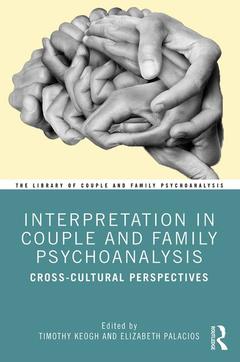Interpretation in Couple and Family Psychoanalysis Cross-Cultural Perspectives The Library of Couple and Family Psychoanalysis Series
Coordonnateurs : Keogh Timothy, Palacios Elizabeth

This collection of contemporary clinically-oriented papers covers a range of theoretical approaches to the fundamentally important technical issue of interpretation. It offers thought-provoking, cross-cultural clinical perspectives about interpretation with illustrations from cutting edge clinical practice with couples and families.
Divided into three sections, the first part of the book examines interpretation within the broader field of psychoanalysis, and notes how it has been applied to couple and family psychoanalysis. Part II considers the current use of interpretation with couples, including how it informs assessment, while Part III focuses on its application with families and considers a broad range of key topics, including the nature of family, social and intergenerational links, the arrival of a newborn, same sex couples? families, bereavement in a family, and families with adolescent children. Each chapter includes a lively discussion piece.
Interpretation in Couple and Family Psychoanalysis: Cross-Cultural Perspectives represents a major contribution to the field of couple and family psychoanalysis. It reflects the fruits of an unparalleled era of global collaboration and the resultant re-shaping of approaches to clinical practice with couples and families. Mental health professionals dealing with couples and families will find it to have immediate relevance to their clinical work, either in their institutional or private practice.
Acknowledgements; About the editors and contributors; Series editor’s foreword,Christopher Clulow; Editor’s Preface,Timothy Keogh and Elizabeth Palacios; Part I: Introduction; Chapter 1: Approaches to interpretation with couples and families; Introduction,Timothy Keogh and Elizabeth Palacios; European perspective,Elizabeth Palacios; British perspective,Mary Morgan; North American perspective,David E. Scharff and Jill Savege Scharff; South American perspective,Janine Puget; Australasian perspective,Timothy Keogh; Part II: Interpretation in couple psychoanalysis; Chapter 2: Complex and creative: the field of couple interpretation,Mary Morgan; Discussant perspective: Hanni Mann-Shalvi; Discussant perspective: Roberta Gorischnik; Chapter 3: The role of interpretation in the assessment phase of couple psychoanalysis,Timothy Keogh and Cynthia Gregory-Roberts; Discussant perspective: Damian McCann; Discussant perspective: Alicia Leisse de Lustgartgen; Chapter 4: Demand analysis: the treatment of the couple,Pedro Gil Corbacho and Carmen Monedero Mateo; Discussant perspective: Rosa Jaitin; Chapter 5: Therapeutic intervention in psychoanalytical clinical work with couples, Miguel Alejo Spivacow; Part III Interpretation in family psychoanalysis; Chapter 6: Interpretation in family analysis, Anna Maria Nicolò and Diana Norsa; Discussant perspective: Carl Bagnini; Discussant perspective: Janine Puget; Chapter 7: Links to the past and to wider social issues in a family assessment, David E. Scharff and Jill Savege Scharff; Discussant perspective: Anastasia Tsamparli; Chapter 8: Interpretation and family psychoanalysis,Mónica Vorchheimer; Discussant perspective: Pilar Puertas Tejedor; Discussant perspective: Jeanne Magagna; Chapter 9: Crossroads in contemporary family clinical practice,Alicia Monserrat Femenia and Elizabeth Palacios; Discussant perspective: Carles Pérez Testor; Discussant perspective: Caroline Sehon; Chapter 10: Fighting the darkness: a family in mourning,Janine Wanlass; Discussant perspective: Susana Muszkat; Discussant perspective: Daniela Lucarelli; Chapter 11: The mess monster: family therapy in the context of the arrival of the newborn brother,Antonia Llairó; Discussant perspective: Sonia Kleinman; Discussant perspective: Juan González Rojas; Chapter 12: The mystery, the turbulence and the passion of infantile phantasy in the couple: whose pain is it – a shared internal world of unmourned objects,Karen Proner; Discussant perspective: Amita Sehgal; Discussant perspective: Anna Romagosa Huguet; Chapter 13: Reflections on interpretation in contemporary clinical practice with family and couple links, Lia Cypel; Discussant perspective: Barbara Bianchini; Epilogue, Timothy Keogh and Elizabeth Palacios
Timothy Keogh is a Training Analyst with the Australian Psychoanalytical Society, Senior Lecturer, Medical School, University of Sydney, Co-chair for Australasia of the IPA’s Committee on Couple and Family Psychoanalysis, a Vice President of the International Association of Couple and Family Psychoanalysis (IACFP) and the Vice President, Australasian Confederation of Psychoanalytic Psychotherapies (ACPP).
Elizabeth Palacios is a Psychiatrist and Psychoanalyst with the Madrid Psychoanalytical Association and the International Psychoanalytical Association. She is Co-chair for Europe of IPA’s Committee on Couple and Family Psychoanalysis (COFAP), and President of the Aragonese Association for the Investigation of Child and Adolescent Psychic Life (AAPIPNA) and a member of FEAP.
Date de parution : 06-2019
15.6x23.4 cm
Date de parution : 06-2019
15.6x23.4 cm
Thème d’Interpretation in Couple and Family Psychoanalysis :
Mots-clés :
Neonatal Intensive Care Unit; Equidistant Interventions; cross-cultural; Janine Puget; interpretation; Vice Versa; clinical practice; Individual Unconscious Phantasies; psychoanalysis; Playing Rooms; international; Analytic Couple Therapy; couple; Mrs Wall; link theory; Conjoint Couple Therapy; families; couples; Family Psychoanalysis; couple psychoanalysis; Inaccessible Mental States; bereavement; Couple Therapy; arrival of a newborn; Couple Link; families with adolescent children; Link Psychoanalysis; social links; Captain Wall; same sex couples; Elena’s Mother; nature of family; Transpersonal Defences; intergenerational links; Psychoanalytical Clinical Work; Couple State; Unconscious Psychic Reality; Feeds Back; CGR; Ball Breaker; Psychological Consultation



